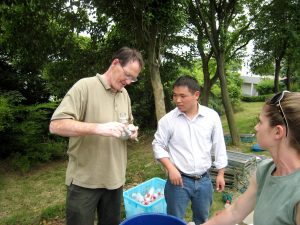
The Bird, Tree & Garden Club’s Brown Bag lecture series will welcome Greg Boyer, a biochemistry professor at the State University of New York College of Environmental Science and Forestry, for a talk at 12:15 p.m. today, July 2, in Smith Wilkes Hall.
The talk, “Algal Blooms: The Good, the Bad and the Beautiful,” will discuss helpful and harmful algae, how human activities affect algal blooms, and what people can do to reduce their harmful impacts on the lake.
“One of the biggest misconceptions people have is they think of algae as a single entity,” Boyer said. “When you talk about people, there are people who are scientists and farmers and criminals and housewives, yet we wouldn’t necessarily lump them all together as a similar entity.”
Boyer has been working with algae for nearly 50 years. He received his bachelor’s degree in biochemistry from the University of California, Berkeley, and his Ph.D. in biochemistry from the University of Wisconsin.
In 1985, he joined the chemistry faculty at the SUNY College of Environmental Science and Forestry.
Boyer previously served as the director of the National Oceanic and Atmospheric Administration Lower Great Lakes project, which developed monitoring strategies for toxic blue-green algae in the lower Great Lakes.
Currently, Boyer serves as the director of the New York Great Lakes Research Consortium, which includes nearly 300 scientists working at more than 20 New York and Canadian universities.
Boyer has been working on research at Chautauqua Lake for about a decade, and this will be Boyer’s second time speaking at Chautauqua Institution.
“We’re going to talk about what blue-green algae actually are,” he said. “Most people don’t know of them other than pond scum. We’re going to talk about why the blooms occur and why we worry about them.”

Boyer said Harmful Algal Blooms, a concern in Chautauqua Lake, occur most often in the heat of the summer and are fueled by an overabundance of lake nutrients such as phosphorus and nitrogen.
Blue-green algae, also known as cyanobacteria, is not always harmful, but can contain toxins that are harmful to the livers and brains of humans and wildlife. The algae can have other detrimental effects and cause rashes for people who are allergic.
In order to tell if an algal bloom is harmful or not, it must be tested, as it is not possible to tell with the naked eye. Boyer said his lab at the SUNY College of Environmental Science and Forestry tests 2,000 to 3,000 algae samples each summer, from bodies of water in New York west of the Hudson River.
In the south basin of Chautauqua Lake, which is more shallow than the north basin, waves stir up lake sediment, releasing legacy nutrients back into the lake, Boyer said.
In the north basin, a lot of phosphorus and nitrogen that enters the lake is a result of human activities such as agriculture and the application of lawn fertilizers on the land surrounding the body of water. Stormwater runoff carries phosphorus and nitrogen on the land into the lake.
The problem is worsened by the presence of hard surfaces like pavement and buildings. Water runoff from impervious surfaces like these will end up in the lake without much natural filtration, while water that is first absorbed by plants and the soil will be cleaner when it enters the lake.
At the Brown Bag lecture, Boyer will discuss some things people can do to reduce the phosphorus and nitrogen runoff from their yards, including using rain barrels and installing rain gardens and buffer strips of plants that are designed to catch and filter water before it enters the lake.
He will also discuss how climate change is expected to have an impact on the growth of algal blooms.




